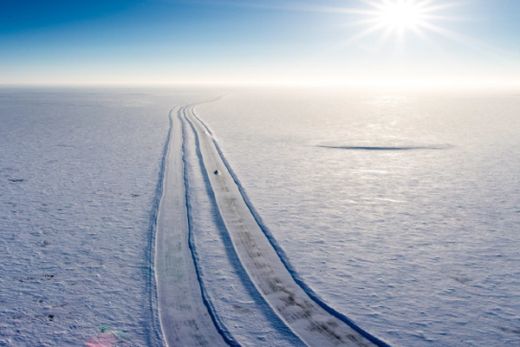|
|
Canada’s Ice Road Opens for Milestone Year
Feb 7, 2019 5:53 AM
By Leah Meirovich
|
|
|

RAPAPORT... February is a crucial time for Canada’s diamond mines.
Located in the most remote region of the country’s frozen Northwest Territories
(NWT), Rio Tinto, Dominion Diamond Mines and De Beers have a two-month window
to connect their mining operations to the outside world.
The winter ice road, officially known as the Tibbitt to
Contwoyto Winter Road (TCWR), opened on February 1, marking the 20th
anniversary that the three companies have jointly run the project. The road was
first constructed in the 1980s to supply the Lupin gold mine, but Lupin later closed,
and the diamond miners took over the project at the start of Canada’s diamond
rush in 1999.
The route is essential for the miners to transport supplies
to their respective Ekati, Diavik and Gahcho Kué mines, which are so isolated employees
can only get to work by helicopter. Without it, work in the mines wouldn’t be
possible, stresses Ron Near, director of the winter road.
“It was clear that if Rio Tinto was to be successful [in
developing Diavik when it was first discovered], they would have to supply
their proposed mine using the ice road,” he explained in an email to Rapaport
News. “Any other approach would have made construction of the mine
unattainable.”
A race to the beginning
Five contractors specializing in engineering, construction,
security, safety and dispatch, build the 600 kilometer stretch at an annual
cost of CAD 20 million ($15.2 million), Near says.
The team of 400 workers began early construction on December
15, clearing the insulating snow from the surface to promote ice growth. The
main construction crew joined on January 1, working in a 30-day window to
complete the project in time for the opening.
Their work isn’t finished now that the road is operating. The
workers must continually manipulate the ice to maintain the route for the
duration of the project, while monitoring a variety of factors such as truck speed,
spacing, and weight. However inconvenient the construction may seem, without
it, mining in the area would not be financially feasible.
“Resupplying the mines any other way would be cost
prohibited,” Near notes. “[They would be] 10 to 20 times higher than using the
road.”
Safety in numbers
Driving on the ice road can be a dangerous job, as much of the
path is built over frozen lakes. A quality-assurance program is set up to
manage the rules of the road and ensure the safety of all users, Near explains.
A total of 22 security officers monitor the trucks with radar guns to make sure
they don’t exceed their maximum speed of 25 kilometers per hour when fully
loaded. It takes 14 to 16 hours for trucks carrying nearly 300,000 tonnes of
freight to travel the 400 kilometers from Yellowknife to the Ekati mine, he
adds.
This year, 600 to 800 drivers in more than 8,300 trucks will
make the journey to and from the mines, dispatched from Yellowknife every 20
minutes, according to Near. They work in teams of up to four, since the drivers
are not allowed to travel the winter road alone and there are three road camps
set up along the route to provide drivers with food, bathing facilities and
emergency maintenance services.
20 years together
As an incentive, the three companies give out 16 safety
awards of CAD 1,500 ($1,138) to deserving drivers every year. To mark the road’s
20th anniversary they’re adding five CAD 5,000 ($3,792) prizes to special
drivers nominated by their contractor companies. In addition, each
participating mine will donate a diamond that will be awarded to three workers
on the project who have shown dedication, support and innovation to make the
project safer and better, Near relates.
The companies recognize that the workers’ efforts are almost exclusively for the benefit of their mines since their is very little other activity in the vast region, and they have a very limited period in which to work. “[The road] is also used to support other exploration
projects, tourist camps and private vehicles, [but] there are no communities
off the road — only the large diamond mines,” he stresses. “After the
project ends, the road eventually melts, and we start all over again the next
year.”
Image: The Tibbett to Contwoyto Winter Road. (Rio Tinto)
|
|
|
|
|
|
|
|
|
|
Tags:
De Beers, Diavik, Dominion Diamond Mines, ekati, Gahcho Kué, Leah Meirovich, northwest territories, NWT, Rapaport News, Rio Tinto, Ron Near, TCWR, Tibbitt to Contwoyto Winter Road
|
|
|
|
|
|
|
|
|
|
|

|
|